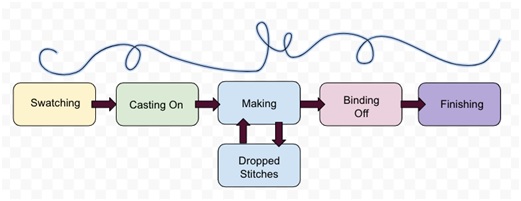A Coaching Model Created by Isobel Phillips
(Leadership Coach, IRELAND)
Introduction
Knitting is a thread that follows me through my life. It helps me focus on video calls, and I knit through classes and labs as I trained to be a coach. I am happy for clients to knit during our sessions if it helps them, but I do not knit as the coach. My knitting connections support me personally and professionally, online, and in person. The metaphor of a cluttered brain being a big tangle of threads that talking can help untangle is a powerful one, and the KNIT model takes this a step further, turning that tangle of thoughts into a finished garment.
Just like yarn, people can all be different. Yarn comes in different shapes, sizes, colors, fibers, textures, and weights, and the appropriate way to treat it will be individual. And like people, through knitting, the yarn has the potential to become all sorts of wonderful things. It can become a toy, a hat, socks, a sweater, a blanket, a plain dishcloth, or an intricate shawl. Patterns allow a prescribed route to be followed, “recipes” give loose structure, or the knitter can go off and figure out their own path as it happens.
Knitting can change direction and become something different from how it started. Dropped stitches can be mended or patched over and moved on from, just as glitches in our past do not need to determine our future. Knitting is made up of a continuous thread that interweaves and builds on itself over and over, becoming more and more complete as it goes, in the same way, that a single narrative runs through our lives, and we build on our learning and experiences as we go.

Swatching
The first step in the KNIT model is to swatch. In knitting, this means studying the yarn, maybe knitting a sample to see what works, and finding the best approach to take for the yarn.
In coaching, this is the discovery session. It’s an opportunity for the coach and the client to meet, to get to know each other, and to discuss what the client might like to achieve through coaching. The parameters of the coaching agreement are established – the number of sessions, the length of sessions if they will take place in person, online, or over the telephone.
Sample questions:
- Can you tell me about your current situation?
- What do you hope to achieve through coaching?
- What’s working and what’s not working for you right now?
Casting On
Casting on is where the work begins. The journey will be determined by the client. Do they want to be a hat, which could be a short and relatively straightforward journey, or a sweater, which might be a longer commitment with different parts that all need to be stitched together? How much untangling needs to take place before you start?
Getting started means establishing the coaching agreement – where does the client want to get to through their coaching journey, and where do they want to get to though the individual session. How do they want to feel at the end? How will they know when they’re there?
Sample questions:
- What would you like to work on today?
- How would you like to feel at the end of our time today?
- How will you know that you’ve achieved your goal?
- In our conversation today, what might be of value?
Making the Garment
This is where the work happens. The approach will be different based on the individual, where they are in their journey, and the appropriate path to take for them. It might mean using the GROW model, exploring their values, using an Appreciative Enquiry approach, undertaking a strengths assessment, and exploring this, or another approach depending on the person.
Sample questions:
- What’s important about this right now?
- What would a better understanding give you?
- What’s keeping you from figuring this out?
- What’s missing right now that you would like to have?
Dropped Stitches
At times in the coaching conversation, it may be necessary to look back at the work completed so far. There may be small errors that draw the eye and are focused on, and these may need to be explored or set aside and moved on from. There may be details that have worked really well, and these can also be highlighted.
Sample questions:
- What impact is this having now?
- What do you need to look at to move forward?
- What’s worked well for you in the past?
Binding Off
Binding off is about planning to take action. It covers designing the steps to take and wrapping things up. Step by step, actions are planned to achieve the goal. New tools may be brought in to help, in the form of supporters for accountability and thinking about the practicalities of putting a plan into action.
Sample questions:
- What would it be like to permit yourself?
- What resources do you have to use?
- What do you need to do?
- What else?
- What’s the first step you need to take?
- What can help you?
Finishing
Finishing a knitting project involves tidying everything up, and washing or blocking it, ready for use. It might mean stitching together different elements or simply sewing in some ends. Blocking a project is washing it and setting it out to make sure it’s in the correct shape when it dries. In coaching this is about reviewing the work done, reflecting on what has been learned and the progress made, and finally in partnering with the client to close the session or program.
Sample questions:
- What are you learning about yourself?
- What opened up for you?
- What do you see about this in other areas of your life?
- What are you taking away?